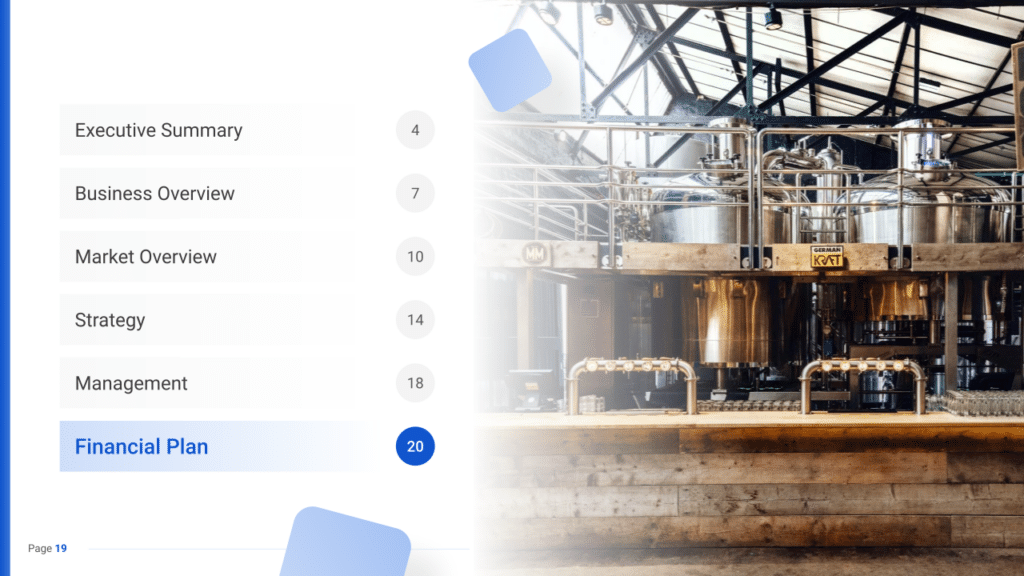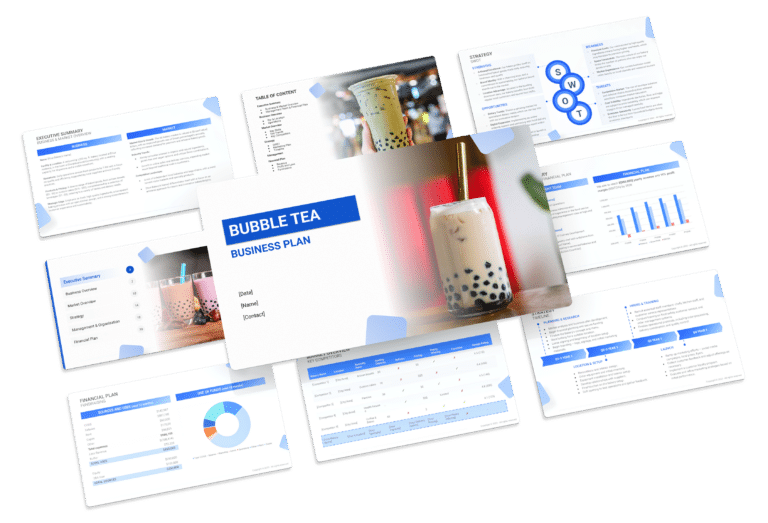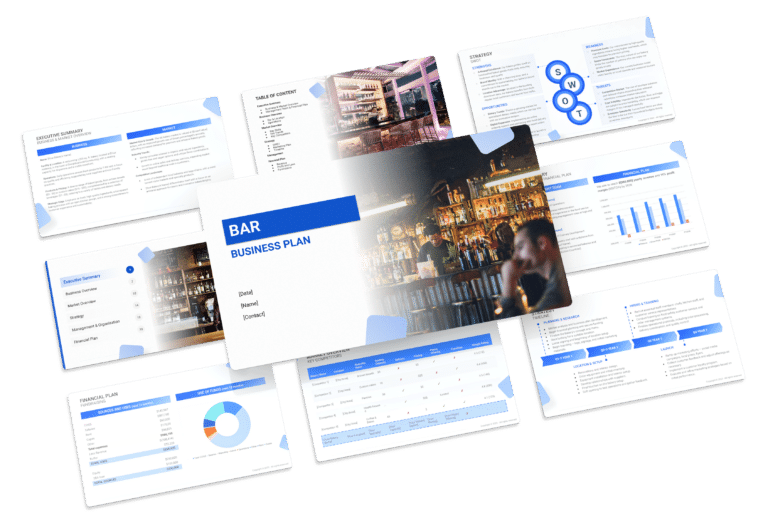Taproom Business Plan Template & PDF Example

Creating a comprehensive business plan is crucial for launching and running a successful taproom business. This plan serves as your roadmap, detailing your vision, operational strategies, and financial plan. It helps establish your taproom business’s identity, navigate the competitive market, and secure funding for growth.
This article not only breaks down the critical components of a taproom business plan, but also provides an example of a business plan to help you craft your own.
Whether you’re an experienced entrepreneur or new to the food and beverage industry, this guide, complete with a business plan example, lays the groundwork for turning your taproom business concept into reality. Let’s dive in!
The Plan
Our taproom business plan is carefully constructed to cover all critical facets needed for an in-depth strategic outline. It delineates the taproom’s operational practices, marketing plans, beverage industry dynamics, competitive positioning, management team organization, and financial estimates.”
- Executive Summary: Provides a concise overview of the Taproom’s proposition, emphasizing a vibrant hub for beer enthusiasts and connoisseurs with a spacious area and an inviting atmosphere. It highlights market analysis showcasing the sector’s growth and demand, the expertise of the management in craft beer and business operations, and a financial plan that outlines investment opportunities and revenue forecasts.
- Business Overview: Offers detailed insights into the Taproom’s operational model:
- Taproom & Location: Describes the taproom’s strategic location in a lively area, designed to offer guests a relaxed setting to enjoy a diverse selection of craft beers, with an emphasis on local and seasonal brews for example.
- Supply & Operations: Details the taproom’s supply chain management, emphasizing partnerships with local breweries to ensure a fresh and diverse selection of craft beers, and outlines efficient inventory management and operations to enhance the guest experience.
- Market Overview: Examines the taproom industry landscape, identifying key players and establishing the taproom’s unique niche:
- Key Stats: Presents data highlighting the market size, growth trends, and statistics that underscore the potential and necessity for vibrant taprooms offering unique craft beer experiences.
- Key Trends: Highlights significant trends such as the growing demand for locally brewed craft beers, the focus on authentic drinking experiences, and sustainability practices in the industry.
- Key Competitors: Analyzes the main competitors in the vicinity, their offerings, and how the taproom’s unique approach and services set it apart.
- Strategy: Outlines the taproom’s strategic plan for growth and establishing a robust market presence:
- SWOT Analysis: Conducts a comprehensive analysis of Strengths, Weaknesses, Opportunities, and Threats to strategically position the taproom.
- Marketing Plan: Details marketing strategies aimed at building brand visibility, attracting new guests, and retaining them through superior service, engaging events, and targeted marketing efforts.
- Timeline: Sets forth key milestones and objectives from the taproom’s setup to its launch and key growth phases.
- Management: Highlights the experienced team leading the taproom, from craft beer experts to business operations managers, emphasizing their roles in ensuring a high-quality beer selection, guest satisfaction, and smooth operations.
- Financial Plan: Projects the financial outlook for the taproom over the next few years, detailing revenue models from beer sales, potentially expanded offerings, and events, cost management strategies, profit margins, etc.

Executive Summary
The Executive Summary introduces your taproom’s business plan, offering a concise overview of your establishment and its offerings. It should detail your market positioning, the range of craft beers, local brews, and other beverages you offer, its location, ambiance, and an outline of day-to-day operations.
This section should also explore how your taproom will integrate into the local market, including the number of direct competitors within the area, identifying who they are, along with your taproom’s unique selling points that differentiate it from these competitors. These could include exclusive brews, events, taproom design, or community engagement strategies.
Furthermore, you should include information about the management and co-founding team, detailing their roles and contributions to the taproom’s success. This could involve their experience in the brewery industry, business management, or community relations.
Additionally, a summary of your financial projections, including revenue and profits over the next five years, should be presented here to provide a clear picture of your taproom’s financial plan.
Taproom Business Plan Executive Summary Example
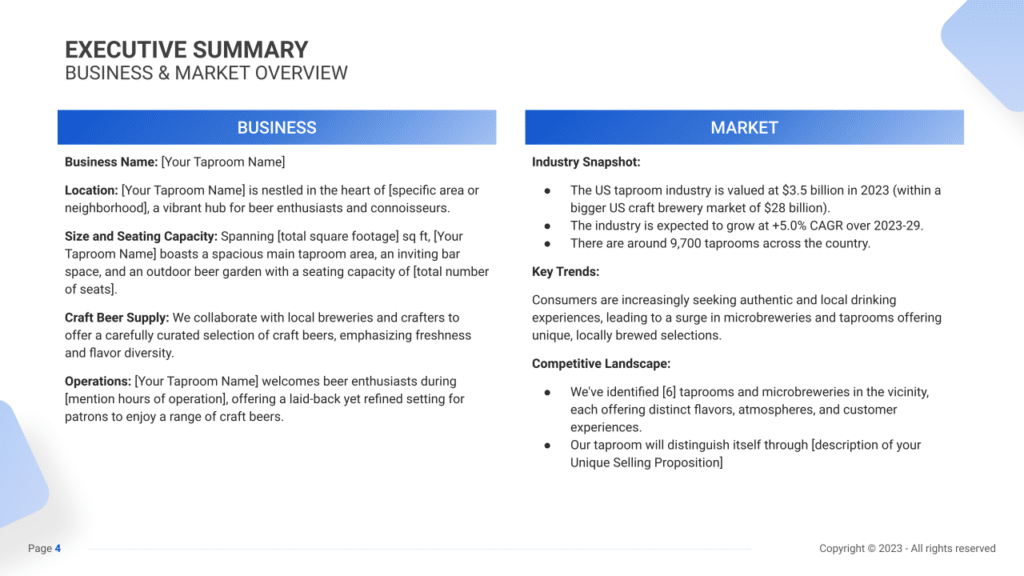
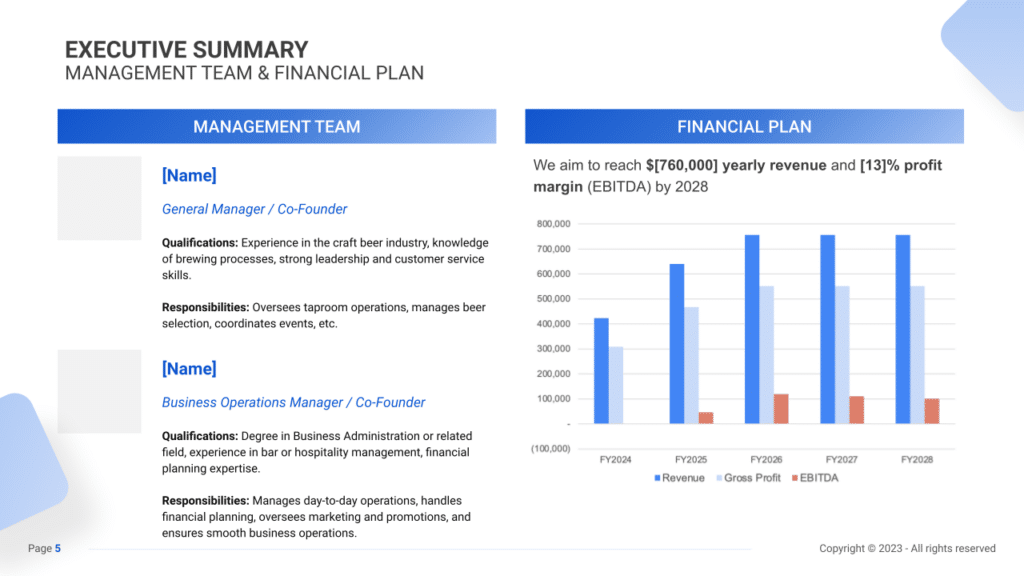
Business Overview
A succinct overview introduces vital details like the taproom’s name, ambiance, craft beer specialties, and a snapshot of its community involvement.
These details lay the groundwork for your taproom, framing its unique characteristics. A unique selling proposition (USP) distinguishes your taproom. Whether it’s a focus on local collaborations, an emphasis on diverse beer flavors, or a welcoming atmosphere, highlight this USP in your executive summary to showcase your taproom’s distinctive value proposition.
Example:
“CraftMingle Taproom,” nestled in the vibrant heart of HopTown, encompasses a spacious 1500 sq ft main taproom area, an inviting bar space, and an outdoor beer garden with seating for 50 patrons. We boast a curated selection of craft beers sourced from local breweries, emphasizing freshness and flavor diversity. Our commitment to fostering a laid-back yet refined setting positions us as a preferred destination for beer enthusiasts seeking a diverse range of craft beers in a welcoming ambiance.
Market Overview
Understanding market dynamics and your position within them is crucial. This section should underscore the potential of the local craft beer scene, supported by relevant data such as consumer preferences for craft beer and market growth rates. Discussing trends, such as the increasing popularity of artisanal brews and the rise in experiential drinking environments, illuminates your taproom’s positioning within the evolving landscape.
Additionally, highlight the community engagement aspects of your taproom. Whether hosting events or supporting local breweries, emphasize your taproom’s involvement within the local beer community.
Example:
The US taproom industry, valued at $3.5 billion in 2023 within the larger US craft brewery market of $28 billion, is projected to grow at a CAGR of +5.0% over 2023-2029. With approximately 9,700 taprooms spread across the country, this sector is witnessing substantial growth, driven by consumer preferences for artisanal brews and experiential drinking environments. CraftMingle Taproom aims to leverage this market growth by focusing on local collaborations and offering a welcoming space for beer enthusiasts to explore diverse craft beer options.
Management Team
Highlight the expertise and background of your management team, showcasing their capabilities in driving taproom success.
This could include your taproom manager’s experience in the craft beer industry or your operations manager’s background in business administration. Demonstrating the team’s competency builds credibility and assures potential investors and partners of your taproom’s potential for success.
Example:
At CraftMingle Taproom, Brewmaster Alex Johnson, with years of experience in the craft beer industry and a deep knowledge of brewing processes, oversees taproom operations, manages beer selection, and coordinates engaging events. Supported by Operations Manager Sarah Clark, holding a degree in Business Administration and expertise in bar management, the taproom maintains a focus on delivering exceptional craft beer experiences and efficient operations.
Financial Plan
Provide an overview of your financial goals and projections, offering insights into revenue targets, profit margins, and anticipated growth trajectories.
Example:
CraftMingle Taproom aims for a projected revenue of $1.8 million annually, targeting a 12% EBITDA profit margin by 2028. Investment in diverse craft beer offerings, strategic events, and marketing initiatives geared towards beer enthusiasts drives anticipated growth and profitability within the local craft beer market.
Business Overview
For a Taproom, the Business Overview section can be concisely divided into 2 main slides:
Taproom & Location
Briefly describe the taproom’s physical environment, emphasizing its design, ambiance, and the overall atmosphere that welcomes patrons. Mention the taproom’s location, highlighting its accessibility and the convenience it offers to patrons, such as proximity to entertainment districts or ease of parking.
Explain why this location is advantageous in attracting your target clientele, which might include craft beer enthusiasts, locals looking for a casual hangout, or visitors exploring the area.
Supply & Operations
Detail the range of beverages offered, focusing on craft beers, local brews, and any unique selections like limited-edition beers or collaborations with local breweries. Outline your sourcing strategy, emphasizing relationships with local breweries and the process for selecting the beers you offer.
Discuss your operational approach, including how you manage inventory, ensure the quality of served beverages, and handle peak times. Highlight any special events, beer tasting sessions, or brewery partnerships that provide added value to your patrons, encouraging community engagement and repeat business.
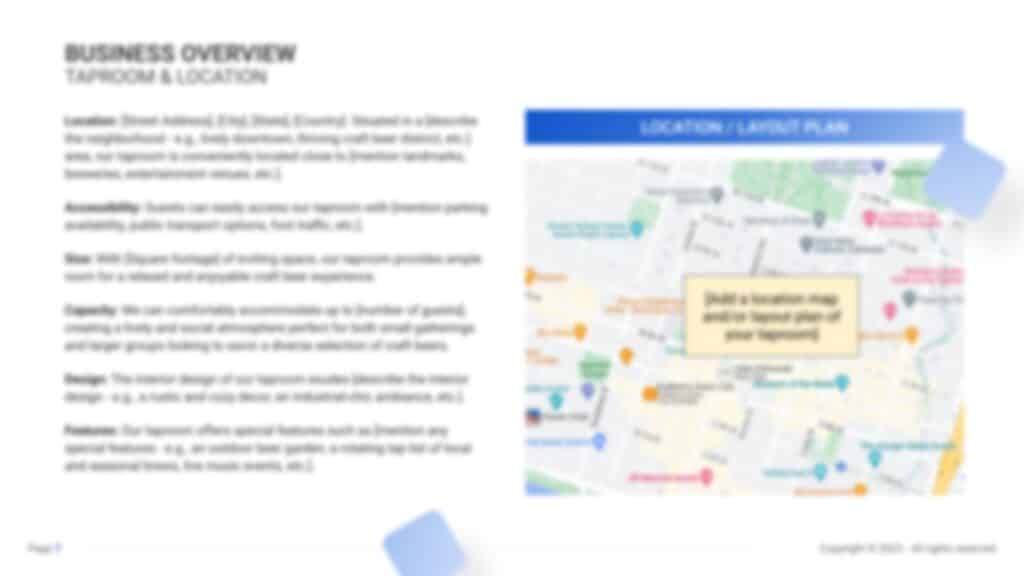
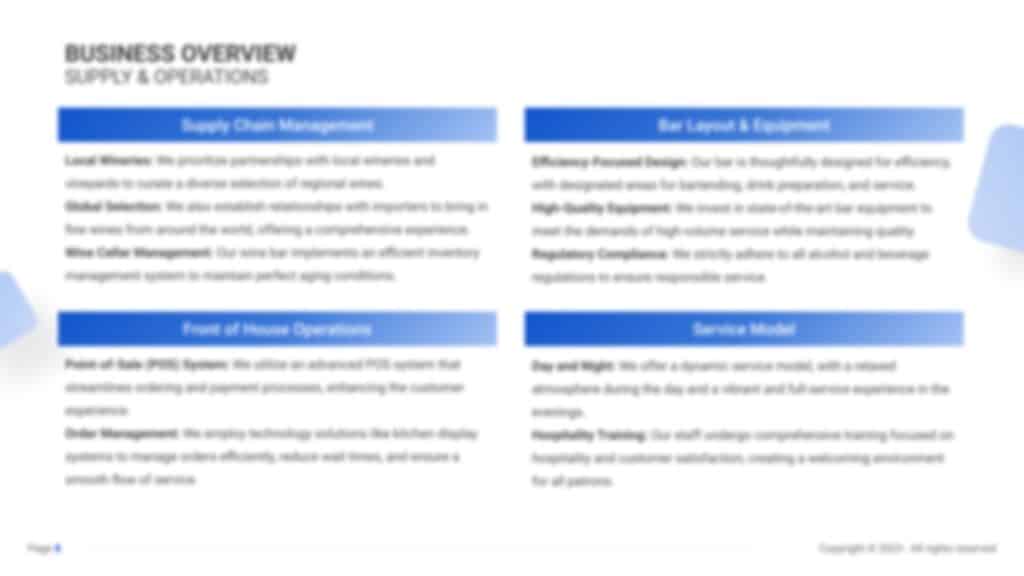
Market Overview
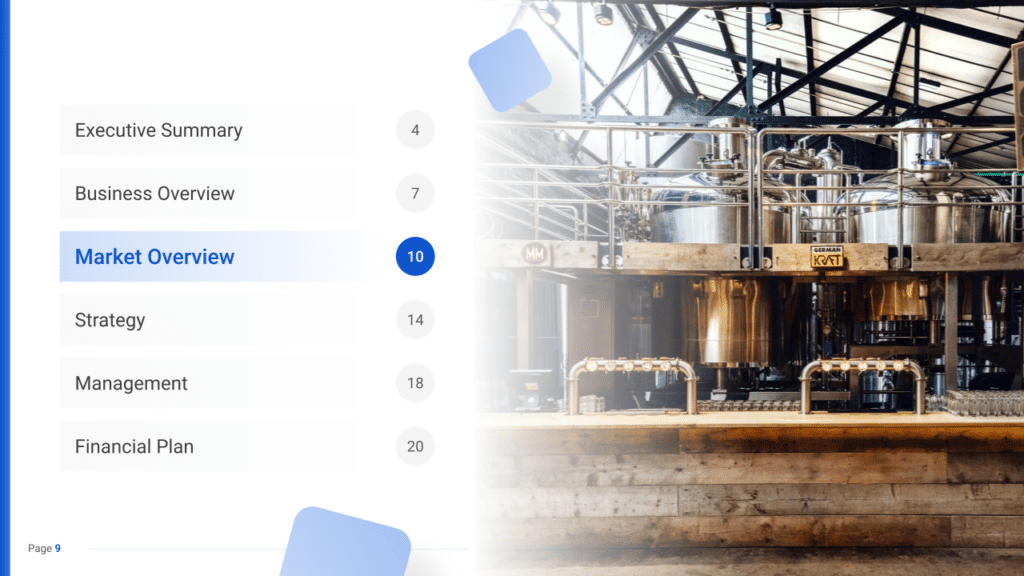
Industry size & growth
In the Market Overview of your taproom business plan, start by examining the size of the craft beer and taproom industry and its growth potential. This analysis is crucial for understanding the market’s scope and identifying expansion opportunities.
Key market trends
Proceed to discuss recent market trends, such as the increasing consumer interest in locally brewed craft beers, specialty and seasonal brews, and the experiential aspect of beer tasting in taprooms. For example, highlight the demand for taprooms that offer a unique experience, such as live music, beer pairing events, or collaborations with local breweries, alongside the rising popularity of taprooms as community gathering spaces.
Competitive Landscape
A competitive analysis is not just a tool for gauging the position of your taproom business in the market and its key competitors; it’s also a fundamental component of your business plan. This analysis helps in identifying your taproom business’s unique selling points, essential for differentiating your business in a competitive market.
In addition, competitive analysis is integral in laying a solid foundation for your business plan. By examining various operational aspects of your competitors, you gain valuable information that ensures your business plan is robust, informed, and tailored to succeed in the current market environment.
Identifying Taproom Competitors
When undertaking a competitive analysis for your taproom, it’s crucial to identify both direct and indirect competitors. Direct competitors are usually other taprooms or breweries within your vicinity that offer a similar range of craft beers and a comparable atmosphere. These establishments directly vie for the same clientele and market share. On the other hand, indirect competitors encompass bars, pubs, or even restaurants that offer craft beers but emphasize different aspects of the dining or social experience, potentially attracting a portion of your target audience.
Leverage various online platforms such as Google Maps, Yelp, Untappd, or BeerAdvocate to map out the geographical distribution of competing taprooms. Customer reviews and ratings on these platforms can provide profound insights into what patrons appreciate about your competitors. For instance, if “Hoppy Trails Brewery” is consistently praised for its friendly staff and diverse beer selection, this feedback indicates areas where your taproom could improve or excel.
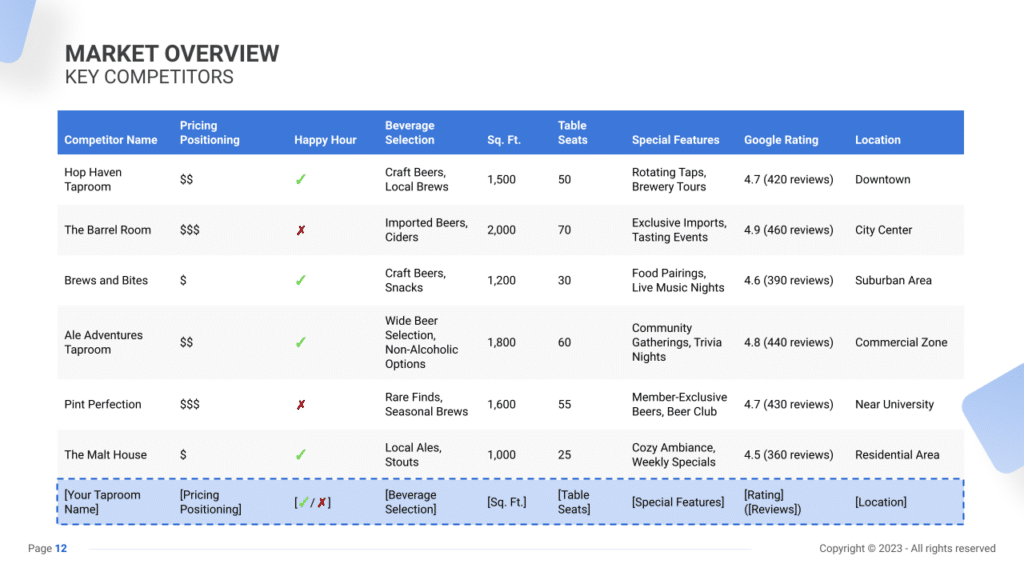
Taproom Competitors’ Strategies
To conduct a thorough analysis of competitors, delve into different facets of their strategies:
- Beer Offerings: Scrutinize the diversity and uniqueness of their beer selections. If “Craft Haven” is gaining recognition for its limited-edition releases and barrel-aged brews, it signals a trend toward specialized and unique offerings.
- Atmosphere and Experience: Evaluate the ambiance, events, and overall customer experience. Does “Brews & Beats” focus on hosting live music events, while “Taste of Suds” offers educational beer-tasting sessions?
- Pricing and Positioning: Compare pricing strategies. Are your beer prices aligned with those of “BrewHub,” targeting the mid-range market, or are they positioned as premium offerings akin to “Craftsmanship Brews”?
- Marketing and Engagement: Assess how competitors engage with their audience. Do they rely on extensive social media campaigns, brewery tours, or collaborations with local artists to bolster their brand?
- Operational Efficiencies: Look for innovative operational processes. For instance, “TechBrew Solutions” might have a mobile app for beer pre-orders or a loyalty program that enhances customer retention.
What’s Your Taproom’s Value Proposition?
Developing a distinct value proposition for your taproom is crucial. This could involve specializing in unique brewing techniques, such as barrel aging, or creating a niche market by focusing solely on organic or locally sourced ingredients.
Take note of market gaps through customer feedback and industry trends. If there’s a growing interest in craft beers infused with exotic flavors or an increasing demand for low-alcohol or non-alcoholic brews, addressing these preferences could provide a competitive advantage.
Consider the influence of your taproom’s location. A downtown taproom might prioritize a lively social scene and offer late-night hours, while a taproom in a suburban area might cater to families and emphasize a more relaxed, community-oriented atmosphere.
Strategy
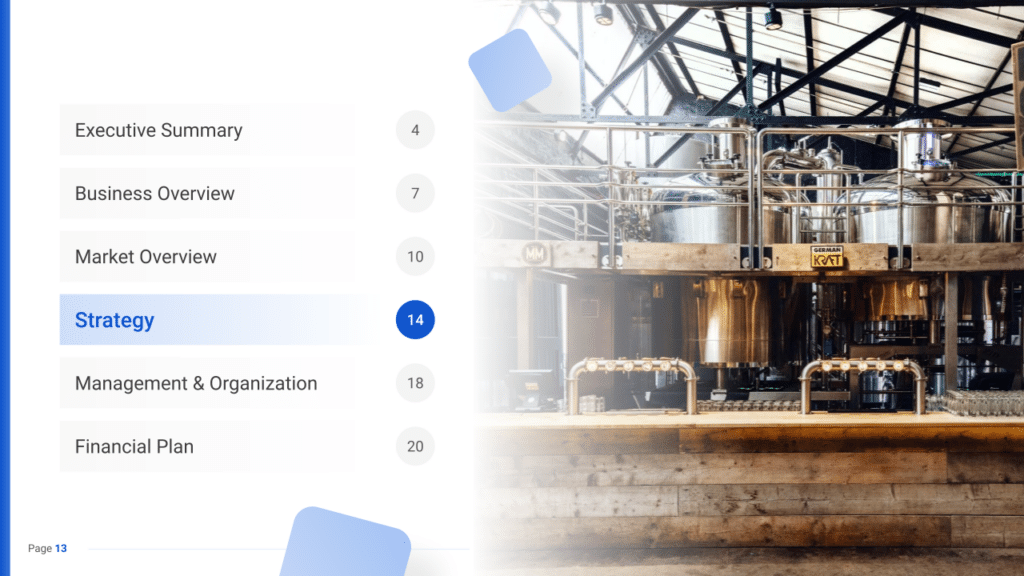
SWOT
First, conduct a SWOT analysis for the taproom, highlighting Strengths (such as a diverse selection of craft beers, a prime location, and a unique ambiance), Weaknesses (including potential regulatory challenges, high startup costs, or strong competition), Opportunities (for example, the growing interest in craft beer and local breweries, potential for hosting events), and Threats (such as changes in consumer spending habits or regulatory changes affecting the alcohol industry).
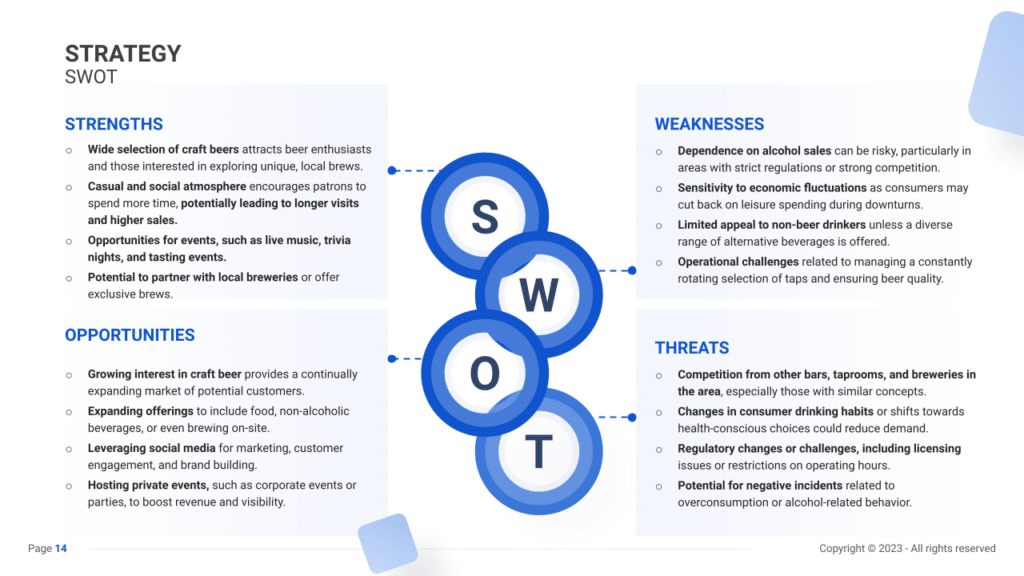
Strengths
A taproom’s strengths are its internal attributes and resources that provide a competitive advantage in the craft beer market. Identifying and leveraging these strengths can be a game-changer for your business.
- Prime Location: Your taproom’s location is a significant strength. If it’s situated in a high-traffic area or near other popular attractions, it can draw in more customers.
- Example: Being located near a popular tourist destination can attract a steady stream of tourists looking to experience local craft beer.
- Unique Beer Offerings: If your taproom offers a wide selection of unique and innovative craft beers, it can set you apart from the competition.
- Example: Brewing exclusive, limited-edition beers that can only be found in your taproom can create a buzz and attract beer enthusiasts seeking something special.
- Knowledgeable Staff: Having a well-trained and knowledgeable staff can enhance the customer experience and foster loyalty.
- Example: Conduct regular beer education sessions for your staff to ensure they can answer customers’ questions and make tailored recommendations.
- Engaging Atmosphere: A taproom with a welcoming and engaging atmosphere can encourage customers to spend more time and money.
- Example: Create a cozy environment with comfortable seating, live music, and themed events to keep customers coming back for more.
Weaknesses
Every taproom has its weaknesses, which are internal factors that hinder its performance. Identifying these weaknesses is the first step in addressing and improving upon them.
- Limited Operating Hours: If your taproom has limited operating hours, you might be missing out on potential revenue during peak times.
- Example: Consider extending your operating hours during weekends or holidays to accommodate more customers.
- Inconsistent Beer Quality: If your beer quality fluctuates, it can result in dissatisfied customers and damage your reputation.
- Example: Invest in quality control measures and staff training to ensure consistency in beer production.
- Limited Marketing Budget: Having a limited marketing budget can restrict your ability to reach a broader audience.
- Example: Explore cost-effective marketing strategies such as social media promotion and collaborations with local influencers.
- Seasonal Fluctuations: Seasonal fluctuations in customer traffic can lead to inconsistent revenue streams.
- Example: Develop seasonal promotions and events to attract customers during off-peak times.
Opportunities
Identifying opportunities is essential for taproom growth. Opportunities are external factors that can benefit your taproom if properly leveraged.
- Craft Beer Trend: The ongoing popularity of craft beer presents an opportunity to tap into a growing market.
- Example: Partner with local breweries to offer a wider variety of craft beers and cater to diverse tastes.
- Events and Collaborations: Collaborating with local businesses or hosting events can attract new customers and create buzz.
- Example: Partner with food trucks for regular events, creating a unique dining experience for customers.
- Online Ordering and Delivery: Offering online ordering and delivery services can expand your customer base beyond those who visit the taproom in person.
- Example: Develop an easy-to-navigate online ordering platform and partner with delivery services for a seamless customer experience.
- Catering and Private Events: Consider offering catering services and hosting private events to increase revenue streams.
- Example: Promote your taproom as an ideal venue for parties, corporate events, and celebrations.
Threats
Threats are external factors that can negatively impact your taproom’s performance. Identifying these threats is crucial for developing strategies to mitigate their impact.
- Competition: Increased competition from other taprooms or bars in your area can lead to a decline in customers.
- Example: Differentiate your taproom by offering unique beer pairings, live entertainment, or themed nights.
- Changing Regulations: Evolving regulations related to alcohol sales and distribution can affect your business operations.
- Example: Stay informed about local and state regulations and adapt your business model accordingly.
- Economic Downturn: Economic downturns can lead to decreased consumer spending on non-essential items like craft beer.
- Example: Develop budget-friendly promotions during economic downturns to retain price-conscious customers.
- Supply Chain Disruptions: Supply chain disruptions, such as ingredient shortages, can impact your beer production and availability.
- Example: Establish relationships with multiple suppliers to mitigate the risk of shortages.
Marketing Plan
Next, develop a marketing strategy that outlines how to attract and retain patrons through targeted advertising, promotional events, a strong social media presence, and community involvement. Consider strategies like hosting beer tasting events, collaborations with local breweries, or participation in community festivals to increase visibility and engagement.
Marketing Channels
Utilize various marketing channels to effectively communicate your brand message and attract beer enthusiasts to your taproom.
Digital Marketing
Leverage digital platforms:
- Social Media: Leveraging social media platforms like Instagram, Twitter, and Facebook is crucial for engaging with the audience. Regularly sharing captivating content, such as brewer profiles, behind-the-scenes glimpses, beer releases, and upcoming events, helps create a vibrant online presence.
- Website and SEO: Maintain an informative, user-friendly website featuring your beer menu, upcoming events, and a blog sharing brewing insights or beer-related content. Optimize your website for local SEO to rank higher in searches for craft beer in your area.
- Email Marketing: Email marketing plays a pivotal role in nurturing relationships with subscribers. Sending newsletters with exclusive discounts, upcoming event notifications, and brewery updates helps maintain customer engagement and loyalty.
Local Engagement
Connect with the local community:
- Host Events: Organize beer-tasting sessions, brewery tours, trivia nights, or live music events to attract locals and create a sense of community around your taproom.
- Partnerships: Collaborate with local food vendors, food trucks, or artisans to offer unique pairing experiences or joint promotional events.
- Sponsorships and Charities: Support local charities or community events to enhance your taproom’s visibility while contributing to the community.
Promotional Activities
Entice potential patrons with compelling offers:
- Happy Hours: Introduce special discounts or happy hour deals on specific beer selections during off-peak hours to attract customers.
- Brewery Memberships: Create membership programs offering exclusive access to limited-edition brews, discounts, or special events for members.
- Referral Programs: Incentivize regulars to bring in new customers by offering discounts or freebies for referrals that result in new taproom visits.
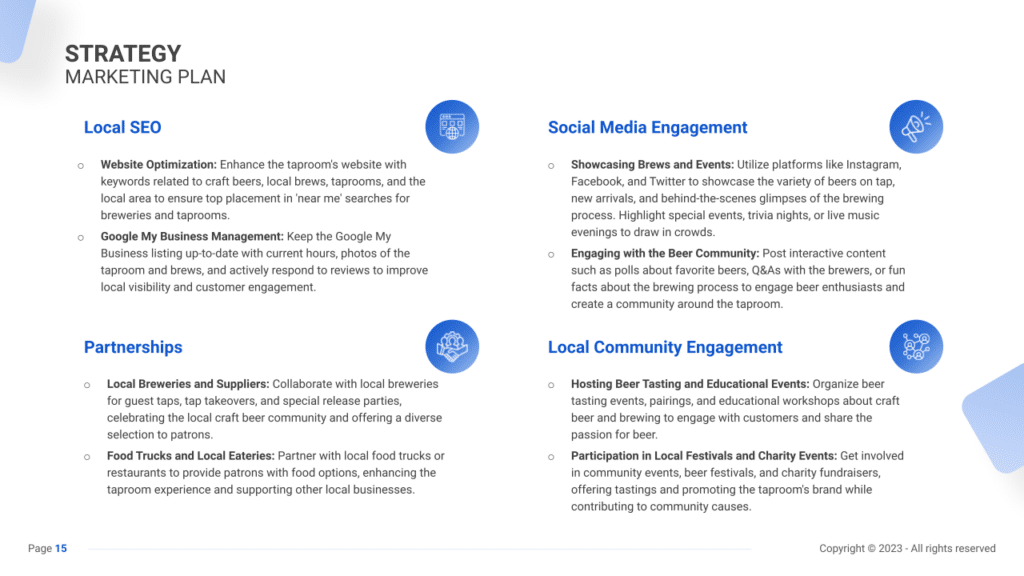
Sales Channels
Effectively manage sales channels to maximize revenue and enhance customer satisfaction.
In-Taproom Sales
Maximize sales within the taproom:
- Upselling: Train staff to suggest beer flights, brewery merchandise, or higher-priced specialty brews to enhance customers’ experiences.
- Merchandise Sales: Display branded merchandise strategically to encourage impulse purchases, such as glassware, apparel, or beer-related accessories.
- Event Ticket Sales: Sell tickets for exclusive beer release events, beer pairing dinners, or brewery tours directly at the taproom.
Online Sales and Booking
Utilize technology to streamline sales processes:
- Online Reservations: Implement an online booking system for brewery tours, tastings, or table reservations, providing convenience and encouraging advanced bookings.
- E-Commerce: Offering e-commerce capabilities on the website for merchandise, limited releases, or gift cards extends the taproom’s reach to customers who might be unable to visit physically.
- Virtual Tastings: Conducting virtual beer tastings or educational sessions with online beer purchases creates interactive engagement opportunities.
Membership and Loyalty Programs
Encourage repeat patronage:
- Membership Benefits: Creating membership programs with tiered benefits, loyalty rewards, or points systems motivates customers to return. These programs can offer perks such as discounts on merchandise, priority access to new releases, or invitations to exclusive member-only events.
- Loyalty Rewards: Develop a loyalty program where customers earn points for every purchase, redeemable for discounts, free tastings, or brewery swag.
Strategy Timeline
Finally, create a detailed timeline that outlines critical milestones for the taproom’s opening, marketing initiatives, patronage growth, and potential expansion objectives, ensuring the business moves forward with clear direction and purpose. This could include key dates for obtaining licenses, renovation completions, the first major event, and periodic reviews of business performance to adjust strategies as needed.

Management
The Management section focuses on the taproom business’s management and their direct roles in daily operations and strategic direction. This part is crucial for understanding who is responsible for making key decisions and driving the taproom business towards its financial and operational goals.
For your taproom business business plan, list the core team members, their specific responsibilities, and how their expertise supports the business.
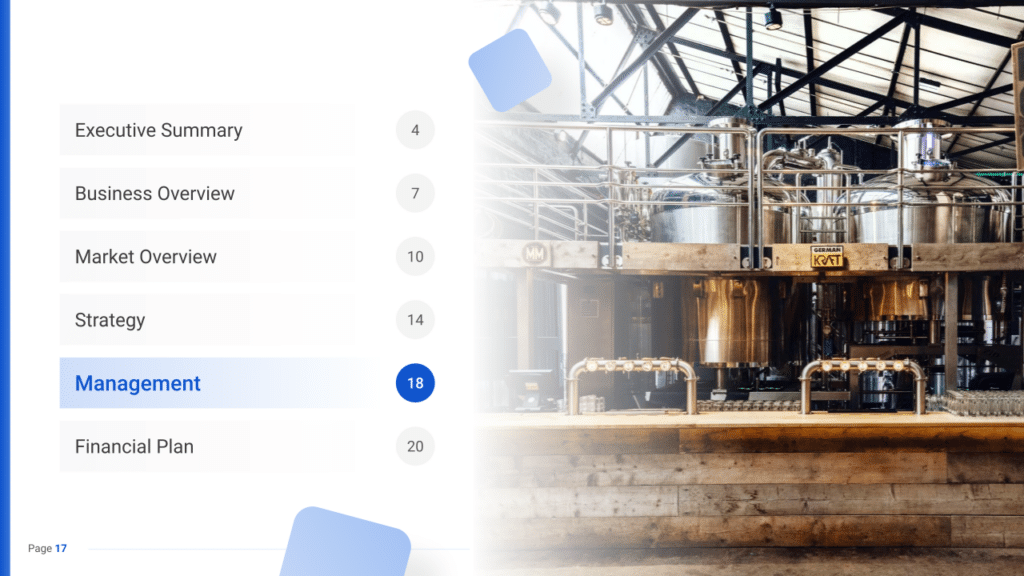

Financial Plan
The Financial Plan section is a comprehensive analysis of your financial projections for revenue, expenses, and profitability. It lays out your taproom business’s approach to securing funding, managing cash flow, and achieving breakeven.
This section typically includes detailed forecasts for the first 5 years of operation, highlighting expected revenue, operating costs and capital expenditures.
For your taproom business plan, provide a snapshot of your financial statement (profit and loss, balance sheet, cash flow statement), as well as your key assumptions (e.g. number of customers and prices, expenses, etc.).
Make sure to cover here
_ Profit and Loss
_ Cash Flow Statement
_ Balance Sheet
_ Use of Funds
